Best Practices for Erosion Control in Construction Projects
Are you working on a building job and worried concerning disintegration control? In this article, we will certainly lead you with the best methods for stopping erosion on your website. hydroseeding. Obtain ready to take on erosion head-on and make certain the success of your building project.
5 Crucial Erosion Control Strategies

To efficiently manage erosion on your construction site, you'll need to implement essential techniques such as slope stablizing and debris control procedures. Incline stabilization is important in stopping soil erosion on high inclines. An additional efficient method is the use of disintegration control coverings or floor coverings, which are put on the slope and aid preserve dirt bits while allowing vegetation to expand.
Efficient Sediment and Runoff Monitoring

You can effectively handle sediment and overflow in your building and construction task by implementing proper erosion control measures. Sediment and runoff management is important to stop disintegration and secure the surrounding setting. One reliable procedure is the installment of silt fencings along the perimeter of the building and construction website. These fencings aid to consist of debris and avoid it from going into close-by water bodies. Another important practice is the execution of disintegration control coverings or mats. These blankets provide a safety layer on bare dirt, minimizing the effect of rainfall and preventing disintegration. Furthermore, the use of sediment containers or debris traps can help to record debris and avoid it from entering stormwater systems. Normal maintenance of these steps is vital to ensure their performance throughout the building project. This consists of checking and cleaning up sediment containers and on a regular basis replacing silt fencings and erosion control blankets as required. By implementing these disintegration control measures, you can successfully take care of debris and runoff in your building and construction job, reducing the influence on the atmosphere and following governing requirements.
Trick Factors To Consider for Slope Stabilization
When considering slope stabilization, it is necessary to assess the terrain and determine prospective locations of instability. You require to carefully analyze the incline's features, such as its angle, composition, and drainage patterns. Seek indicators of disintegration, such as exposed roots, cracks, or slumping soil. These indicators can give you an idea of where stabilization measures may be necessary.
Another alternative is to plant plants on the slope, as the origins can assist secure the soil and control disintegration. Furthermore, installing disintegration control coverings or floor coverings can provide instant protection while plants becomes well-known.
It's important to frequently monitor the supported slopes to ensure their performance. Watch out for any indicators of motion or disintegration, and take instant activity if required. Normal maintenance, such as evaluating and repairing any type of broken actions, is additionally necessary to ensure long-lasting security.
Best Practices for Plants and Dirt Protection
One efficient way to secure vegetation and dirt on slopes is by on a regular basis checking for indicators of erosion and taking prompt action if needed. Start by checking the slope for any type of indicators of erosion, such as revealed roots, bare soil spots, or sediment build-up at the base. Implement erosion control procedures such as mounting erosion control blankets, mulching, or also constructing maintaining wall surfaces if needed.
Carrying Out Correct Drainage Solutions
To effectively my site execute correct drainage systems, it's important to take into consideration the slope gradient and soil type. Understanding these elements is necessary when it comes to taking care of water circulation and preventing erosion. The slope gradient plays a considerable duty in determining exactly how water crosses the land. Steeper inclines can find out here bring about much faster water circulation, increasing the risk of erosion and flooding. On the other hand, gentler slopes allow water to flow more slowly, reducing erosion potential. By analyzing the slope gradient, you can develop an efficient drain system that fits the natural water motion.
Soil type also affects water drainage system style. Different dirt kinds have varying levels of leaks in the structure, influencing exactly how water is taken in and drained. As an example, sandy dirts have a tendency to drain faster because of their rugged texture, while clay dirts have a slower drain rate as a result of their small nature. Recognizing the dirt type aids in choosing appropriate water drainage methods, such as making use of absorptive materials or mounting French drains. In addition, thinking about the soil features helps protect against waterlogging, which can cause poor plant development and damages to structures.
Final Thought
In verdict, when it comes to disintegration control in building and construction jobs, you need to follow these best methods. Think about incline stabilization methods to guarantee the stability of the site. By adhering to these essential practices, you can properly regulate disintegration and guarantee the success of your construction project.
To properly regulate erosion on your construction website, you'll require to execute important techniques such as incline stabilization and sediment control actions. Slope stabilization is essential in avoiding dirt erosion on steep inclines. One more reliable method is the use of disintegration control blankets or website here floor coverings, which are put on the slope and aid keep soil bits while allowing plant life to grow. Another choice is to plant greenery on the slope, as the origins can help secure the soil and control disintegration. Implement erosion control procedures such as installing disintegration control blankets, mulching, or also constructing maintaining walls if required.